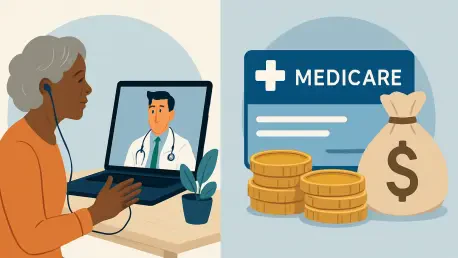As the clock ticks toward October 1, the U.S. healthcare system braces for a pivotal moment that could reshape access to vital services for millions of Medicare beneficiaries, with key virtual care programs like telehealth flexibilities and the Acute Hospital Care at Home (AHCAH) waivers facing potential expiration. Unless Congress passes a short-term government funding bill by midnight on that date, these initiatives, significantly expanded during the COVID-19 pandemic, could end, threatening the delivery of remote consultations and home-based acute care that ease the burden on traditional hospitals. Yet, with a government shutdown looming if lawmakers fail to act, the future of these services hangs in a precarious balance. The situation underscores not only the transformative power of virtual care but also the fragility of its funding structure, raising urgent questions about whether political gridlock will undermine a critical component of modern healthcare delivery for vulnerable populations across the nation.
The Transformative Impact of Virtual Care
The rise of virtual care has fundamentally altered how healthcare reaches Medicare beneficiaries, offering unprecedented convenience and access. Telehealth flexibilities enable patients to receive consultations directly from their homes, spanning both rural and urban communities, while also expanding the pool of providers who can deliver these services, such as physical and occupational therapists. Meanwhile, the AHCAH program has gained significant traction, supporting 419 initiatives across 147 health systems in 39 states. This wide adoption reflects a growing reliance on home-based acute care as a viable alternative to traditional hospital stays. Policymakers, providers, and advocacy groups largely agree that these programs are no longer just supplementary but form a critical pillar of healthcare delivery, especially for aging populations or those with mobility challenges who benefit immensely from reduced travel and in-person visits.
Beyond accessibility, virtual care has proven its worth in alleviating pressure on overburdened healthcare facilities, a lesson hard-learned during the pandemic. By allowing patients to receive high-quality care without stepping into a hospital, these programs have helped manage capacity issues and reduce infection risks in clinical settings. The data speaks volumes—millions have utilized telehealth for routine check-ups, mental health support, and chronic condition management, while AHCAH has enabled complex treatments at home under professional supervision. This dual approach not only enhances patient outcomes by fostering comfort and familiarity but also cuts costs for both individuals and the broader system. However, the looming deadline threatens to unravel these gains, casting doubt on whether such innovations can persist without stable financial backing from Medicare, which underpins their widespread availability.
Risks on the Horizon for Patients and Providers
Should funding for virtual care lapse on October 1, the immediate consequences could ripple through the healthcare ecosystem with alarming speed. Providers face a daunting dilemmcontinue offering telehealth and AHCAH services without guaranteed reimbursement or suspend them entirely, potentially disrupting care for countless patients. The Centers for Medicare & Medicaid Services (CMS) has already issued guidance instructing hospitals to transfer AHCAH patients back to brick-and-mortar facilities or discharge them by September 30 if no extension is secured. This directive poses significant logistical challenges, as moving patients mid-treatment can compromise continuity of care and strain hospital resources already stretched thin. The uncertainty alone is enough to unsettle healthcare operations nationwide.
Compounding the issue is the financial disparity among providers, which could dictate vastly different responses to a funding gap. Larger, more financially secure health systems might opt to maintain virtual care services, gambling on retroactive payments once Congress resolves the impasse. In contrast, smaller or less-resourced entities, particularly those serving underserved communities, may have no choice but to halt operations, leaving patients without critical access. This uneven playing field risks exacerbating existing inequities in healthcare delivery, as Medicare beneficiaries in rural or low-income areas could bear the brunt of service interruptions. The potential for such widespread disruption highlights the urgent need for a resolution that prioritizes patient welfare over fiscal uncertainties, ensuring that access to innovative care models isn’t dictated by a provider’s balance sheet.
Political Standoffs Threaten Progress
At the heart of the virtual care funding crisis lies a contentious political battle over broader government spending priorities. Democrats are leveraging the debate to push for extensions of Affordable Care Act subsidies, a move that has created a deadlock with Republicans and heightened the risk of a full government shutdown if no compromise is reached by the October 1 deadline. Despite bipartisan acknowledgment of the importance of telehealth and AHCAH programs, these initiatives have become collateral damage in a larger fiscal tug-of-war. The frustration among healthcare stakeholders is palpable, as the programs’ proven benefits are overshadowed by partisan disputes that have little to do with their direct impact on patient care.
This political gridlock reveals a troubling disconnect between policy consensus and legislative action, leaving virtual care in a vulnerable position. While both parties have voiced support for extending these Medicare programs, their entanglement with unrelated budgetary demands has stalled meaningful progress. Advocacy groups and providers watch helplessly as negotiations drag on, aware that a failure to pass a continuing resolution could halt government operations entirely, further complicating the path to a solution. The situation serves as a stark reminder of how systemic inefficiencies in Congressional decision-making can jeopardize even the most widely valued healthcare innovations, putting millions of beneficiaries at risk of losing access to essential services.
The Burden of Short-Term Solutions
The current funding cliff is not an isolated event but part of a frustrating pattern of temporary fixes that have plagued virtual care programs over the past year. Telehealth flexibilities have narrowly avoided expiration on multiple occasions, with short-term extensions—such as three months in late 2024 and six months earlier this year—providing only fleeting stability. These stopgap measures, while preventing immediate collapse, perpetuate a cycle of uncertainty that hampers long-term planning for healthcare providers. Hospitals and virtual care companies struggle to allocate resources or expand services when the future of reimbursement remains unclear, ultimately affecting the quality and consistency of patient care.
Legislative efforts to break this cycle, such as the CONNECT for Health Act and proposals for multi-year extensions, aim to establish permanence or at least longer-term security for virtual care. However, these initiatives remain mired in Congressional inaction, unable to gain traction amid broader funding disputes. The recurring nature of these near-misses underscores a systemic failure to prioritize sustainable policy over reactive measures. For Medicare beneficiaries, this instability translates to anxiety over whether their access to remote consultations or home-based treatments will vanish overnight. The healthcare community continues to call for decisive action that moves beyond patchwork solutions to solidify virtual care’s place in the system.
Uneven Capacity to Weather the Storm
A critical challenge emerging from the funding uncertainty is the disparity in how providers can respond to a potential lapse in Medicare reimbursement. Larger, financially robust health systems may choose to sustain telehealth and AHCAH services during a shutdown, banking on eventual retroactive payments once funding is restored. This calculated risk, while admirable, is not an option for smaller or less financially stable entities, particularly those in rural or economically challenged regions. As experts from advocacy groups have noted, these providers may be forced to suspend operations, leaving gaps in care that disproportionately affect vulnerable populations who rely heavily on Medicare-supported virtual services.
This uneven capacity to navigate a funding interruption threatens to deepen existing inequities within the healthcare landscape. Patients in underserved areas, already facing barriers to traditional care, could find themselves cut off from vital remote options, exacerbating health disparities. The situation highlights a structural flaw in the system, where access to innovative care models hinges not just on policy but on a provider’s financial resilience. Without targeted support or clear assurances from CMS, the risk of uneven service delivery looms large, prompting urgent questions about how to ensure equitable access during times of fiscal uncertainty for all Medicare beneficiaries.
Charting a Path to Stability
Amid the looming threat of funding cuts, advocacy groups are stepping up efforts to secure clarity and protections for providers caught in the crosshairs of political delays. Organizations like the Alliance for Connected Care are urging CMS to issue explicit guidance on retroactive billing and to shield providers from penalties if they continue virtual care services during a lapse. This push for administrative support reflects a broader demand for stability, ensuring that care delivery isn’t derailed by bureaucratic or legislative holdups. The healthcare community’s frustration is evident—while the value of telehealth and AHCAH is undisputed across political and professional lines, the reliance on last-minute resolutions continues to undermine confidence in the system.
Looking back, the repeated brinkmanship over virtual care funding exposed critical vulnerabilities in how healthcare policy was managed. The urgency of past deadlines, like the one on October 1, forced stakeholders to confront the need for lasting solutions over temporary patches. Moving forward, the focus must shift to actionable steps, such as advancing legislative proposals for permanent extensions and ensuring CMS provides robust safety nets for providers. Collaborative efforts between lawmakers, regulators, and advocacy groups are essential to prevent future cliffs, securing virtual care as a reliable fixture for Medicare beneficiaries. Only through such coordinated action can the healthcare system safeguard access and innovation for the long haul.









